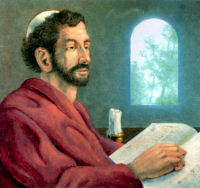
Pope Saint Martin I
Image: Catholic Culture
(EWTN) Born in Italy at Todi on the Tiber, Pope Martin was born in either the late 6th or early 7th century, he became a Deacon according to Catholic News Agency and served in Rome, where he acquired a reputation for education and holiness.
Pope Theodore I chose Martin as his representative (Papal Nuncio) to the Emperor in Constantinople during a period of theological controversy between the Imperial Capitol and the Roman Church.
The dispute that Martin became involved first as Papal Nuncio and later as Pope himself, was over Jesus’ human nature. (See: Galatians 4:4 and ‘Jesus Christ, God and Man’ –EWTN) Although the Church had already acknowledged the Eternal Son of God as ‘becoming man’ within history, some Eastern Bishops continued to insist that Christ’s human nature was not entirely like that of other humans.
During the 7th century, authorities within the Byzantine Church and empire, promoted a version of this heresy known as ‘monothelitism’ which taught that Jesus Christ had two natures–one human and one divine but only one will.
Pope Theodore condemned this teaching and excommunicated Patriarch Pyrrhus of Constantinople for holding to it.
Martin inherited this controversy when he succeeded Theodore I as Pope. At the Lateran Council of 649 Pope Martin I, followed his predecessors lead in condemning Pyrrhus’ successor Patriarch Paul II, who accepted Emperor Constans II decision to forbid all discussion of whether or not Jesus Christ had both a human and divine will–Pope Martin I condemned monothelitism completely and denounced those who held to it.
Pope Martin insisted that the teaching that denied Christ’s human will could not be glossed over as an irrelevant point. To refuse to acknowledge Jesus Christ’s distinct divine and human wills he believed, was to deny the Biblical teaching that Christ was like humanity in everything other than sin.
“For we have not a high priest who is unable to sympathize with our weaknesses but one who in every respect has been tempted as we are, yet without sinning.” —Hebrews 4:15
The Byzantine Emperor retaliated against Pope Martin by sending his own representative to Italy during the Council, with Orders either to arrest the Pope or have him killed.
A servant of the Emperor who attempted to assassinate Pope Martin while he was distributing Holy Communion later testified that he suddenly lost his eyesight and could not carry out the death sentence.
In 653 the Emperor again sought to silence Pope Martin, this time by sending a delegation to abduct him, a struggle ensued and the Pope was taken to Constantinople before being exiled to the Island of Naxos for a year. Those who attempted to send help to the exiled Pope Martin, were denounced as traitors of the Byzantine Empire–Eventually Pope Martin was brought back to Constantinople and sentenced to death.
Pope Martin’s appointed executioners stripped him of his clothes and led him through the city before locking him in a prison with a group of murderers–he was beaten so badly that he appeared to be on the verge of death. At the last moment however both the Patriarch of Constantinople and Emperor agreed that Pope Martin should not be executed and instead was kept in a prison before being banished again to an island that was suffering from severe famine. Pope Martin wrote to a friend that he was “not only separated from the rest of the world…even deprived of the means to live” and here passed the remaining days of his life.
Buried in the Church of Our Lady in Crimea Cherson, many miracles are related are wrought by Pope Saint Martin I in life and after his death in 655 — Pope Saint Martin was the last of the early Pontiff’s to be Venerated as a Martyr.
The Third Ecumenical Council of Constantinople eventually vindicated Pope Saint Martin I, by confirming in 681 that Jesus Christ had both a divine and human will.
More here from Franciscan Media
Related: For Today’s Most Holy Scripture Readings – Memorial of St. Martin I, Pope & Martyr Visit: -USCCB